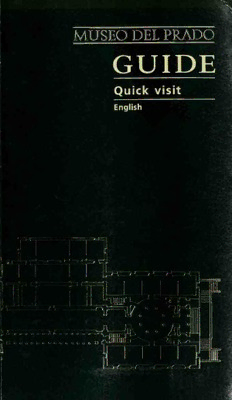
Museo del Prado Guide Quick Visit PDF
Preview Museo del Prado Guide Quick Visit
MUSEO PRADO DEL GUIDE 'm •f,S Quick visit .v«r^ m m V:*«S;J "mrnm^ f^M^y-if?^ m'"^.r. U^M I i"^^m^^ y';^^^'' .r^^jj,^ v^«^. ii. b ..r-T"'; 1/ -'^'^.rj'-:^^ n 1 *** -. Angelico, Fra 36 PoussiN, Nicolas 28 i Bermejo, Bartolome 2 ''^ Pradilla, Francisco 49 Bosch 4-5 H-.-*: Raffaello de Urbino 38-39 Botticelli, Sandro 37 Rembrandt 12 &,„,,^,,.^^ Brueghel, Peter 7 Reni, Guido 42 Caravaggio 41 RiBERA, Jose de 22 DuRER, Albrecht 8 RosALES, Eduardo 48 "''*', Fortuny, Mariano 46 Rubens, Peter Paul 9-10 \^f^ Goya 13-15-16-17-18 OnyxSaltcellar 14 w,.^'j. Iti "',' Greco, El 29-30-31 Sorolla, Joaquin 47 Gris. Juan 50 **'- - Tintoretto 34 Leoni, Leone and Ponpeo 40 Titian 32-33 !^ .ii Lopez Portana, Vicente 44 Van der Weyden, Roger 3 j& Maderuelo, Santa Cruzde 1 Van Dyck, Anton 11 Madrazo, Federico de 45 Velazquez, Diego de 23-24-25-26-27 Madrazo, Jose de 43 Verones 35 MoR, Anthonis 6 ZuRBARAN, Francisco de 21 Murillo, Bartolome Esteban 19-20m '&Li' '. r^" MUSEO DEL PRADO GUIDE Quick visit Alicia Quintana ALDEASA 7-^1 ''"^'mmMM *^i.;ST.- ^^ .y,\>A«vS Angelico, Fra 36 Poussin, Nicolas 28 Bermejo, Bartolome 2 Pradilla, Francisco 49 v-tJaV^-"^ -V'-'J Bosch 4-5 Raffaello de Urbino 38-39 Botticelli, Sandro 37 Rembrandt 12 'i i/JJ'-J.j Brueghel, Peter 7 Rfni, Guido 42 ".^ Caravaggio 41 Ribera, Jose de 22 Durer, Albrecht 8 Rosales, Eduardo 48 FoRTUNY, Mariano 46 Rubens, Peter Paul 9-10 g™""^ Goya 13-15-16-17-18 OnyxSaltcellar 14 Greco. El 29-30-31 Sorolla, Joaquin 47 : Gris, Juan 50 Tintoretto 34 Leoni, Leone and Ponpeo 40 Titian 32-33 Lopez Portana, Vicente 44 Van der Wevden, Roger 3 Maderuelo, SantaCruzde 1 Van Dyck. Anton 11 Madrazo, Federico de 45 ,'*jri VelAzquez, Diego de 23-24-25-26-27 ^ Madrazo, Jose de 43 Verones 35 MoR, Anthonis 6 Zurbaran, Francisco de 21 MuRiLLo, Bartolome Esteban 19-20 MUSEO DEL PRADO GUIDE Quick visit Alicia Quintana o^^ ALDEASA ThemamHallIn«EIComercio» Museum Th e The Prado Museum is a neo-Classical building by the ArchitectJuan de Villanueva, the construction ofwhich began in the year 1785. It was conceived ofas a museum and natural history room forming part ofa building complex dedicated to the study ofscience, as planned under the reign ofCharles III and within the scope of the urban reform that took place on the Paseo del Prado (previously named Salon del Prado), which was also embellished with various monumental fountains (Cybele, Apollo and Neptune). It was established in 1819 as the «Royal Museum ofPainting and Sculpture)) by King Ferdinand VII, with pieces from the royal collections amassed by earlier Spanish Monarchs, his forebears. At the end ofthe 19th century, the Museum —by then national — in scope received works from another museum, then called the Trinity, that were ofa eclesiastic nature and which had been expropriated under laws governing the depreciation ot ecclesiastic assets. From the time ofthe creation and merger of the two museums many other works ofart have been added to the Prado through donations, legacies and acquisitions. t ' rl I. : f 1 ^«^ W/ „; , Brambila.ThePradoMuseum,around1840 Brambila NorthRotundaofthePradoMuseum,around1830 Only a tenth ofthe museum's artistic holdings are actually on display in its two buildings, the Villanueva Building and the Cason del Buen Retire. The remainder is held in other places, museums, institutions and Government buildings or in storage at specially conditioned sites within the two museum buildings. The large museum collections fundamentally include paintings. However, there is a valuable collection ofsculptures, drawings, furniture, luxury art, coins and medallions that cannot be permanently displayed due to lack ofspace. The Painting collection (12th to the 20th century) is displayed as followed: up to the 18th century and Goya's work is in the Villanueva Building, and the 19th and 20th centuries' work in the nearby Cason del Buen Retiro. The fundamental painting collections belong to the Spanish schools — — the best represented and the Italian and Flemish schools. The French, Dutch and German schools, though numerically less represented, are not unworthy ofmention vis-a-vis their quality. Two halls are expressly reserved for sculpture, but sculptural pieces are scattered throughout the different halls in both museum buildings. All decorative art is on display in what is known as the Dauphin's Treasure. The tour we propose will allow you to view the fifty most famous pieces ofthe museum. The normal placement ofthese pieces are indicated, though it is possible (due to remodeling or temporary expositions) these may be found to have been altered. Ifthis is the case, the museum guards will provide turther information.
